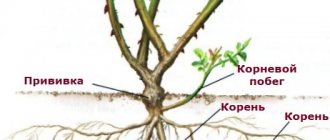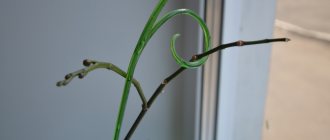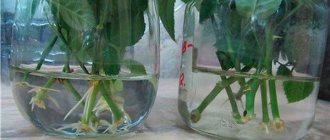How many leaves should a rose have?
Experienced gardeners are sure that the correct answer to the question of how many leaves a rose has is 5 pieces. Only rose hips can have a larger amount. This opinion appeared at a time when the number of varieties was quite limited.
rose foliage
Today there are at least 30 thousand types of roses in the world, and many new varieties appear every year. They can have 3, 5, 7, 9, 11, 13 leaf plates. The number does not indicate whether the bush belongs to a garden or wild crop.
Important! The non-standard number indicates the domestication of the subspecies. When a new variety is obtained, the hybrid is capable of producing both 7 and 9 plates.
Differences between rose and rose hip flowers
The flowers of both plants are bisexual and have a double perianth. The calyx has sepals that are fused together. Depending on the type of plant, the flowers are arranged in inflorescences or separately.
As already mentioned, a rose hip flower has five petals, although decorative cultivated varieties can also be double (for example, the “wrinkled” variety has about 180 petals). A rose has many petals and a core, which is not visible during flowering. The middle of the rosehip is always visible.
Rose
As already mentioned, after flowering has finished, rose hips begin to form fruits with seeds inside, while roses lose their petals without any fruit set. The color of rosehip petals is predominantly pink (occasionally white). Roses bloom in a rich range of colors.
Differences between climbing roses and simple and bush varieties of roses
During the growing season, it is difficult to confuse bush, standard, simple and climbing roses. Its characteristic features include:
- The climbing rose has 7 leaves;
- shoots reach from 3 to 5 m;
- the crown is spreading, the branches are highly flexible, they can easily be placed in a shelter before wintering;
- leaf blades are painted in dark green tones;
- the plant needs support.
The leaves of a rose are drying up - what could be the reasons?
A simple count of leaves does not give anything; when purchasing a seedling, special attention should be paid to the place where the stems and roots grow together. Almost all young animals from bush and ordinary representatives are obtained by vaccination. The cultural bud is planted:
- on rose hips - budding;
- on the rootstock of a wild relative - copulation.
At the junction, in the area of the root collar, a thickening is formed. It is used to determine the variety and whether it belongs to a climbing or regular subspecies.
Variants capable of weaving are propagated by cuttings and layering. They are classified as self-rooted - climbing roses do not have additional growth in the root collar area. Vaccinations of such varieties are carried out only when necessary, if this is required by the characteristics of the breeding origin.
Such knowledge is needed for beginning flower growers. In a nursery or agricultural complex, young animals are sold in containers with open or closed root systems, and a wax layer is applied to the branches. When purchasing, you need to take a closer look at the root collar; if the plant is to curl, then it will not have any foreign growths in the specified area. The advantage of climbing species is the absence of secondary wild growth and the impossibility of gradual degeneration.
Important! When choosing a seedling, special attention should be paid to the area located below the scion. If a living bud is localized there, the flower quickly transforms into a wild one, which is difficult to fight.
Bush and climbing variety
General rules for caring for roses
Thanks to the work of breeders, modern varieties of this crop can grow almost everywhere. However, for abundant flowering, it is better to plant them in a sunny place in well-drained soil, and then feed them in a timely manner, regularly water them, prune them and carry out preventive treatments against diseases. There is a certain set of rules for caring for a plant:
- Proper planting of the seedling and creating conditions for its rooting are important. It is better to give preference to a plant with a closed root system. When buying seedlings with bare roots, you need to look at their condition. There should be a lot of roots and they should not look dried out.
- You should not immediately chase a large collection of varieties. It’s better to start by purchasing 1-2 varieties and learning how to care for them. In the future, you can purchase other roses to decorate your site.
- The ideal place for planting this flower would be an area where it can sunbathe for 6-8 hours daily. In the northern regions, it is better to plant the crop near the fence and wall of the house on the south or west side, providing them with protection from the cold wind. If the soil at the planting site is not very fertile in composition, it must be fertilized.
Planting roses
- It is necessary to comply with planting deadlines. It is necessary to plant either in early spring or in the fall a month and a half before the onset of frost, so that the plant has enough time to take root. The event is best held on a cloudy day.
- In order for the flowering to be luxurious, the rose needs fertilizing. It is recommended to apply organic fertilizers monthly, and mineral complexes - twice per season, in spring and autumn. It is recommended to feed a newly planted plant with organic matter alone until it blooms. At the time of flowering, you can add granules with minerals.
- The soil on which roses grow should always be kept moist. Watering is regulated taking into account the composition of the soil and weather conditions. On sandy soil, roses require more frequent moistening. During hot and dry periods, flowers should be watered daily, avoiding water getting on the leaves.
- The main pruning of roses should be done in early spring. During it, all damaged, weak and diseased shoots are removed, and healthy branches are shortened by half of last year's growth. It is also necessary to regularly remove faded buds to stimulate the appearance of new flowers. In grafted roses, you need to cut out wild shoots to zero.
Basic rose pruning
To keep roses healthy, it is better to purchase disease-resistant varieties. To prevent the appearance of powdery mildew, it is necessary to carry out thinning pruning, which will ensure good air exchange inside the bush. In order not to provoke the appearance of black spotting, roses are watered at the root, preventing moisture from getting on the leaves. Insecticides are used to control pests.
Compliance with all the recommendations outlined will give you the opportunity to enjoy long, luxurious flowering and the aroma of roses in your area. Flowers grown with one's own hands bring special joy to the gardener.
How to distinguish a rose from a rose hip
Both options are considered close relatives:
- Rosehip is able to take root in various conditions and is characterized by a high level of endurance. Heat and severe frosts do not affect it; by nature it has strong roots, it does not need pruning or feeding. The root system independently provides the bushes with the necessary nutrients, extracting them directly from the soil.
- The rose is distinguished by its tenderness and capriciousness; it blooms only with proper care. By the number of leaves it is easy to distinguish between domestic and wild counterparts.
How to revive roses after winter - what to do
The main signs that help to recognize them include:
- The branches of rose bushes have a reddish tint, and over time the shoots turn green. Rosehip individuals initially have greenish shoots that are thrown out from the roots, while in roses they appear above the point of contact between the root system and the stem.
- The thorns of the cultivated variety are sparsely growing and have large spines. “Wild” shrub has small, sharp and thin thorns.
- Rose bushes are decorated with bright and glossy leaf blades. In rose hips they are smaller, with curves clearly visible at the tip.
Important! Rosehip has 7 leaves on its petiole, the same number is found in its cultivated counterparts.
Shoot differences
Proper pruning of rose hips (how not to turn a rose into a rose hip)
The differences are clear, but why do roses turn into rose hips, how to avoid this, and what to do? To answer these questions, let’s figure out how a decorative representative of the species gets into our garden. The plant can have its own root system, or it can be grafted onto the so-called “rootstock”. The latter case is more common, because with such grafting, rose bushes are more resistant to soil, pests, and changing climatic conditions. And all because the rootstock is a wild representative of the species. That is, very often a rose seedling has a root and basal part from a rose hip and only an upper shoot from an ornamental rose. If you take a closer look at the seedling, it has a thickening at the bottom from which shoots extend. At the site of thickening, cuttings of a cultivated species are grafted onto a wild plant. A rose with its own root system does not have this. If you suddenly notice that shoots that are bright green in color are growing from the root of the rose bush, you need to get rid of them.
There are times when you can see wild shoots a meter from a rose bush. They also need to be removed. They take away the strength of the main plant, which makes it grow and bloom worse.
Any seedling on the market or in a nursery, know that they are all grafted onto rose hips. This means that the moment will come when the “owner of the rose roots” - the rose hips - will appear from under the ground. If you do not remove it in time, it will quickly kill a more delicate rose, and you will have to remove the entire bush. Therefore, rose hips need to be dealt with at a tender age.
Since the graft is usually located underground, the rosehip shoot grows directly from the ground. Remove it as quickly as possible. To do this, carefully dig up the rose to the grafting site and, making sure that the shoot grows below the grafting, cut it out at the very base. Shoots that grow above the grafting do not need to be touched.
The main "don't"
When pruning rosehip shoots, never leave stubs behind. Otherwise, dormant buds may awaken on them, and then instead of one rose hip sprout you will get a whole bush. That is why you need to dig up the soil around the bush, expose the graft and remove such shoots completely. Be sure to look where the shoots are coming from. Everything above is a varietal rose, everything below is wild.
It's worth noting that there are exceptions to these rules. Some varieties of spray roses with small flowers have 7 leaves per branch and rather small thorns. They are very decorative, although they look like rose hips, and, moreover, they are unpretentious. Mature shoots of such roses are brown, the flowers are of different shades depending on the variety.
Main differences
There are 4 differences that will allow you to distinguish rose seedlings from rose hips:
- Young shoots of roses are dark red, gradually turning green and woody. Rose hips, on the contrary, have bright green young shoots.
- There are three or five leaves on a leafy branch of a rose. There are seven leaves on a rosehip branch.
- The leaves of the rose are quite large, smooth, shiny, dark green. Rosehip leaves are lighter, smaller, have a pronounced structure and do not shine.
- The thorns of pink shoots are large and sparsely located on the stem. Rosehip shoots are entirely covered with small short thorns; there are also spines on the sepals and leaf petioles.
What roses have 7 leaves?
Is it necessary to bury a rose graft when planting?
Long-term selective selection has improved the quality characteristics of roses. The process continues to this day in nurseries and institutes, which makes it possible to obtain new varieties. But the work done could not completely change the gene pool and the plant regularly appears with a non-standard number of foliage.
How many leaves does a climbing rose have? Polka and Flammentanz have 7 sheets each. A similar amount is found in park ground cover species. These include Lipstick and Kleinstrauhrose. The same feature is found in Floribunda, which belongs to the Pilgrim. Their decorative effect does not suffer from the number of plates. The five-leaved subspecies included Monica, Flamingo and Paradise.
Rose Polka
How to save rose cuttings in winter
If you decide to postpone growing roses until spring, it's time to take care of the safety of the cuttings during the winter. You can do this as follows:
dig a hole 15 cm deep in the garden, cover its bottom with covering material (cotton cloth) and place the cuttings there. Mark the edges of the hole with pegs to make it easier to find the stored shoots in the spring;
- remove the leaves and place the cuttings at equal distances from each other;
- cover the cuttings with the remaining cloth and sprinkle with soil;
- In the spring, after the snow melts, dig up cuttings and inspect them. On “established” cuttings, callus is formed - a thick growth on which roots are formed;
- after extraction, it is advisable to immediately plant the cuttings in a cutting box or in a permanent place;
- if planting is delayed for a day or more, place the cuttings in a container with water (it is recommended to add a few drops of Epin to it).
What to do if a rose degenerates into a rose hip
The gradual wilding of a varietal plant disheartens any gardener. This anomaly is observed in grafted varieties, when a weak culture is attached to a strong base. In this situation, the root system throws out its own shoots and if the problem is not dealt with, the scion quickly dies.
Important! The identification of wild game occurs through a thorough examination of the bush. It begins to grow a short distance from it or is located exactly under the bush. In some cases, shoots appear up to 2 m from the mother plant.
The emerging green branch is distinguished by increased thorniness and 7 leaf blades on the petiole. It develops and grows rapidly, after a few months it thickens and grows up to 1.5 m.
You can prevent this unpleasant phenomenon when purchasing seedlings - they should be purchased from trusted places. There should be no living growth buds on the rootstock. The threat of degeneration can be reduced if the root collar, when planting, is initially deepened to the bayonet of a shovel, and not 5 or 7 cm.
Wild growth near a rose
When foreign growth appears, the following measures are taken:
- In the area where the shoot appears, you need to remove the soil to get to the root system. This approach will help determine the growing area of the game.
- Trim the wild shoot using pruning shears. The cut should be deep, capturing part of the root.
- The pruning area must be disinfected with iodine solution, the soil should be leveled and compacted in the area around the trunk.
- After three days, spray the entire plant, including leaf blades, with a water-superphosphate mixture (50 g per 1 liter of heated liquid, the composition is additionally diluted in a bucket of water). The manipulation should be repeated several times during the season.
Important! Wild shoots should not be cut at soil level - this will lead to increased bushiness and complicate the fight against unwanted growth.
Preventive cutting is carried out as the rose hip shoots form. The desired result is not always achieved from the first treatment. To preserve the varietal qualities of the rose, it should be transferred to its own root system:
- Immediately after the ground thaws in early spring, dig a ditch near the bush.
- Place last year's stem in it and secure along the entire length with pins. Leave the tip of the branch in a vertical position.
- Sprinkle a mixture of peat and humus on top. Care for the cuttings all summer, during which time they take root.
- Cutting from the mother bush is carried out the next season, at the same time the shoot must be transferred to a new place.
Important! This method of propagation is suitable for varieties that have increased frost resistance.
The process of degeneration is characterized by an accelerated pace due to a lack of useful substances in the graft. Depleted soil and insufficient bait provoke a lag in the development of roses and active growth of the root system of the base.
All procedures must be carried out on a proactive basis. Every month you need to inspect the area of the root collar, and break off the emerging shoots. They tend to grow parallel to the soil surface for more than a meter before emerging.
Removing wild shoots
What is the difference between self-rooted roses and grafted roses?
To decide which roses are better - grafted or own-rooted - you need to find out about all their advantages and disadvantages. There are quite a lot of differences between the species. To successfully grow a rose garden in a garden plot, it is recommended to choose both, since they have differences that can be beneficial.
Advantages of each type of roses, their endurance
When choosing shrubs to decorate your garden plot, you need to pay attention to their description. Frost resistance of plants does not play a special role in choosing the type of rose, since they will have to be covered in any case
Roses will recover on their own roots if at least one bud survives. Grafting plants somewhat weakens them, and therefore the bush will survive if the bud is covered with soil. However, rooted flowers are more frost-resistant
The frost resistance of plants does not play a special role in choosing the type of rose, since they will have to be covered in any case. Roses will recover on their own roots if at least one bud survives. Grafting plants somewhat weakens them, and therefore the bush will survive if the bud is covered with soil. However, self-rooted flowers are more frost-resistant.
Grafted plants develop faster and begin to bloom earlier. Varieties of root-bearing roses take longer to develop, and therefore begin to differ in decorative properties closer to the age of five. Another point follows from this - grafted flowers are less viable.
Important! It only makes sense to graft roses if you want to see flowering earlier, but it will be less abundant compared to plants with their own roots. It makes sense to plant in an area with nearby groundwater only with ungrafted plants
The rose's own roots go 50 cm underground, while those of the grafted ones go 1 meter underground. Caring for a plant involves fertilizing the soil, and in the first case it will be easier to do it
It makes sense to plant in an area with nearby groundwater only with ungrafted plants. The rose's own roots go 50 cm underground, while those of the grafted ones go 1 meter underground. Caring for a plant involves fertilizing the soil, and in the first case it will be easier to do.
Grafting bushes is quite difficult, something not every gardener can handle, but growing from cuttings is easy if you follow the instructions.
Rosebud covered with frost
The difference between the species is not as striking as it might seem at first glance, but these little things are quite significant when growing and caring for a rose garden.
Which roses don't run wild
Wild growth cannot be found on rose bushes with their own roots. If they were not initially grafted onto the base, then they are not in danger of going wild. This type of shrub is not able to withstand adverse weather conditions: sudden changes in temperature or harsh winter. They require winter shelter:
- climbing varieties must be placed in trenches, having first been removed from the trellises;
- Cover the bushes with spruce branches and mulch.
Own-root varieties take root well in the southern regions, and flower beds in the middle and northern latitudes will become impoverished without grafted roses. Therefore, flower growers will have to regularly fight wild growth.
In order not to look for the answer to the question of how many leaves a garden rose should have, it is enough to familiarize yourself with the varietal characteristics of the young plants. Grafted varieties may have 5, 7 or 9 leaf blades located on the petiole. To prevent them from going wild, it is necessary to regularly remove foreign shoots growing from the root system of the base.
How not to confuse a climbing rose with a rose hip
Spring gives the gardener a better chance not to confuse a varietal rose with a “wild” one when the overwintered seedling begins to grow.
- First of all, we carefully examine the regrown shoots and remember that in a cultivated rose they are red, while in a rose hip they are bright green.
- As the branches grow, the color changes only in varietal roses.
- Over an equal period of time, noticeably more young leaves appear on the rosehip.
- On climbing roses, young leaves are reddish, on rose hips they are light green.
- When the leaves gain strength, they become dense and dark on cultivated roses, but on rose hips they remain thin and light.
- The biggest difference is the spikes. On a rose they are large and sparse, on a rose hip they are small, but very thick and prickly.
Sometimes at the nursery you can see such a picture. Thin, green shoots appear from the ground next to the dense reddish shoots. This means that the rootstock, that is, the rosehip on which the variety is grafted, has become active. This phenomenon is more typical for grafted bush roses than for climbing roses. This is another distinguishing feature between different types.
In any case, if such a situation arises, you need to get rid of the shoots. Otherwise, the rosehip will suppress the graft, and the variety will degenerate.
You need to watch standard roses even more vigilantly; they may develop not only root shoots, but also shoots on the stem. They must be disposed of ruthlessly. Otherwise, years of painstaking work will be in vain.
But this property of rose hips will never manifest itself on self-rooted climbing roses.
Characteristic features of various types
Each type of rose has its own unique features.
Hybrid tea
The most numerous species. They grow from 60 cm to 1 meter in height. The bushes are slightly spreading, the branches are straight. They have very high quality flowers. The main characteristic is the pointed shape of the inflorescences. Flowers are double and densely double. They look very impressive as a standard plant.
English (David Austin)
Roses from a famous English breeder. Tall, have a very large, wide flower. A distinctive feature is the strongest aroma. The number of varieties of this group is already more than 200. However, officially, they have not yet been identified as a separate species. They have incredible demand in the flower market.
Climbing
This is the name for roses with long shoots that entwine the support. They decorate arches, canopies, and pergolas. There are two types - creeping and climbing. The former bloom once a year and require annual pruning. The latter have several waves of flowering per season. No pruning needed.
Polyanthas (multiflorous)
Dense, small bushes up to 40 cm tall. Small flowers are collected in large inflorescences - up to 100 roses in one. They have almost no smell, but they bloom continuously from late spring to late autumn. They tolerate frost well. In greenhouse and indoor conditions, forcing is possible.
Park
These include ancient varieties that can survive harsh winters in open ground. A bush one and a half meters high. They bloom in early summer for about a month. The flowers look like rose hips. Their color varies from white to purple. Sometimes it is orange. Used in group plantings and hedges. The wrinkled rose also belongs to this species.
Ground cover
This is a new group. Roses of this type are easily recognizable: the branches grow mainly to the sides, sometimes up to 4 m. The height is no more than 50 cm. The flowering is long-lasting. They have shiny leaves. They grow in a continuous carpet. Some varieties of this type bloom once, others 2 times. Serve as an excellent decoration for any site. They don’t get sick and aren’t afraid of frost.
Standard
They are not a separate species. These are roses grown using special techniques. A cultivated rose is grafted onto a single, long rosehip shoot. It can be of any variety and type. It turns out a pink tree in the form of a huge bouquet. It is considered the best garden decoration.
Miniature
This species was recently bred by breeders. The height of the bush is from 15 to 25 cm. The stems are densely covered with small, shiny leaves. They can be with or without spikes. The flowers are very small, of different colors. They bloom singly or in inflorescences until the first frost. Grown in borders or in containers. Growing in an apartment is allowed. The species tolerates frost well and does not get sick. It is weakly affected by pests.
Curb
Low-growing shrubs up to 70 cm high. They quickly take root in a new place. They bloom long and profusely. They differ from ordinary roses in their double flowers with fancy edges and unusual shapes. Can be grown in apartments.
Bush (another name is scrubs)
Large bushes up to 2 meters high. They can be either upright or semi-climbing. Less capricious than tea varieties. Pruning is not difficult even for beginners. They require shelter for the winter. Flowering is long and abundant. They are used in both vertical and horizontal gardening.
The method proposed above for determining the type of roses, of course, will require some work, but if you delve deeply into its essence, you can very well become the owner of the key to solving any grown flower.
Classification of roses
This is a conditional grouping of roses based on characteristic garden characteristics. The modern classification was adopted in 1976 by the World Federation of Rose Societies. The latest version was published in 2000.
The vast majority of rose varieties cannot be attributed to any natural plant species based on morphological characteristics. That is why the basis of classification is not origin, but decorative and biological characteristics.
For your information! The classification is very conditional. Even varieties belonging to the same type can differ greatly in biological characteristics.
According to the shape of the inflorescences, all types of roses are divided into:
- simple - have 7 petals;
- semi-double – 8-20 petals;
- terry - from 20 to 30 petals;
- densely double – from 30 to 60.
According to the growth pattern, roses can be divided into three categories:
- Vertically growing.
- Drooping.
- Ground cover type.
The variety of varieties is divided into several types:
- Hybrid tea.
- English (aka David Austin roses).
- Climbing.
- Polyanthaceae.
- Park ones.
- Ground cover.
- Standard ones.
- Miniature.
- Borders.
- Bush.
Reference! Park, border and shrub species may include roses from any other category.











